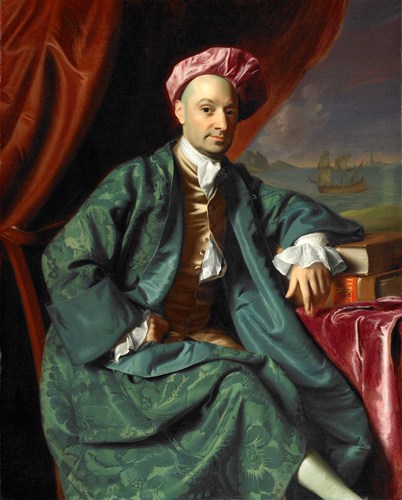“For a Noble Man, a Prince”: Images and Identity in Colonial America
Phyllis Hunter, University of North Carolina, Greensboro
Paul Staiti, Mount Holyoke College
Looking into a Merchant’s Home
First: Look at this rendition of a British-American parlor from the late eighteenth century and roll over the highlighted areas to get more information. These are objects that might be found in the home of a successful merchant living in British North America. Each object, in its own way, visually declares the identity of the owner.

Second: Look at a colonial portrait of Nicholas Boylston by John Singleton Copley. When Massachusetts merchants wanted to celebrate their stature they sought out the best known portraitist of their time. In 1769 Nicholas Boylston (1716-1771) was a wealthy and stylish international merchant who had made his fortune, like many enterprising colonists, during the Seven Years War (1754-63). His firm made its mark by importing the sort of consumer goods-textiles, paper, tea and glass-that Bostonians eagerly sought. Boylston was typical of the colonial merchant aristocracy that wished to use goods to fashion its identity. Boylston was a Loyalist who supported English rule in America. In the aftermath of the Townshend Acts of 1767, which taxed common imported goods, that was a potentially dangerous position. During the subsequent American boycott of English goods, Patriot leader Samuel Adams attacked Boylston’s continued trade with England, and in 1769 revolutionaries seized his ship and impounded its cargo of imported goods. While you are looking at this portrait, think about how painter and patron worked together to make a statement about class and status in the Anglo-American world of late colonial British North America. What details catch your eye? Why?
Figure 1: Nicholas Boylston (1716-1771), 1767 John Singleton Copley, American, 1738-1815, oil on canvas Source: Harvard Art Museum, Fogg Art Museum, Harvard University Portrait Collection
Use the slider to zoom in and out of the image
Figure 1: Nicholas Boylston (1716-1771), 1767 John Singleton Copley, American, 1738-1815, oil on canvas Source: Harvard Art Museum, Fogg Art Museum, Harvard University Portrait Collection
Use the slider to zoom in and out of the image
Third: Click on the red boxes on the portrait, examine the details, and read the accompanying information. Review your initial conclusions about what you thought was significant.

Fourth: Read another perspective on Nicholas Boylston:
Dined at Mr. Nick Boylstones, with the two Mr. Boylstones, two Mr. Smiths, Mr. Hallowell and the Ladies. An elegant Dinner indeed! Went over the House to view the Furniture, which alone cost a thousand Pounds sterling. A Seat it is for a noble Man, a Prince. The Turkey Carpets, the painted Hangings, the Marble Tables, the rich Beds with crimson Damask Curtain and Counterpins, the beautiful Chimny Clock, the Spacious Garden, are the most magnificent of any Thing I have ever seen.
Diary and Autobiography of John Adams, ed. Lyman H. Butterfield, Cambridge, 1961, I: 294.
Adams’s statement demonstrates not only Boylston’s taste and class, but also his position as “a noble Man, a Prince” connecting him to the English elite.
Fifth: After examining the portrait’s details and reading about its sitter, write 2-3 sentences about your impressions of the Nicholas Boylston portrait. Has your opinion changed from your first observation? Did John Adams’s statement affect your view? and If so, what did it reveal about the portrait…
